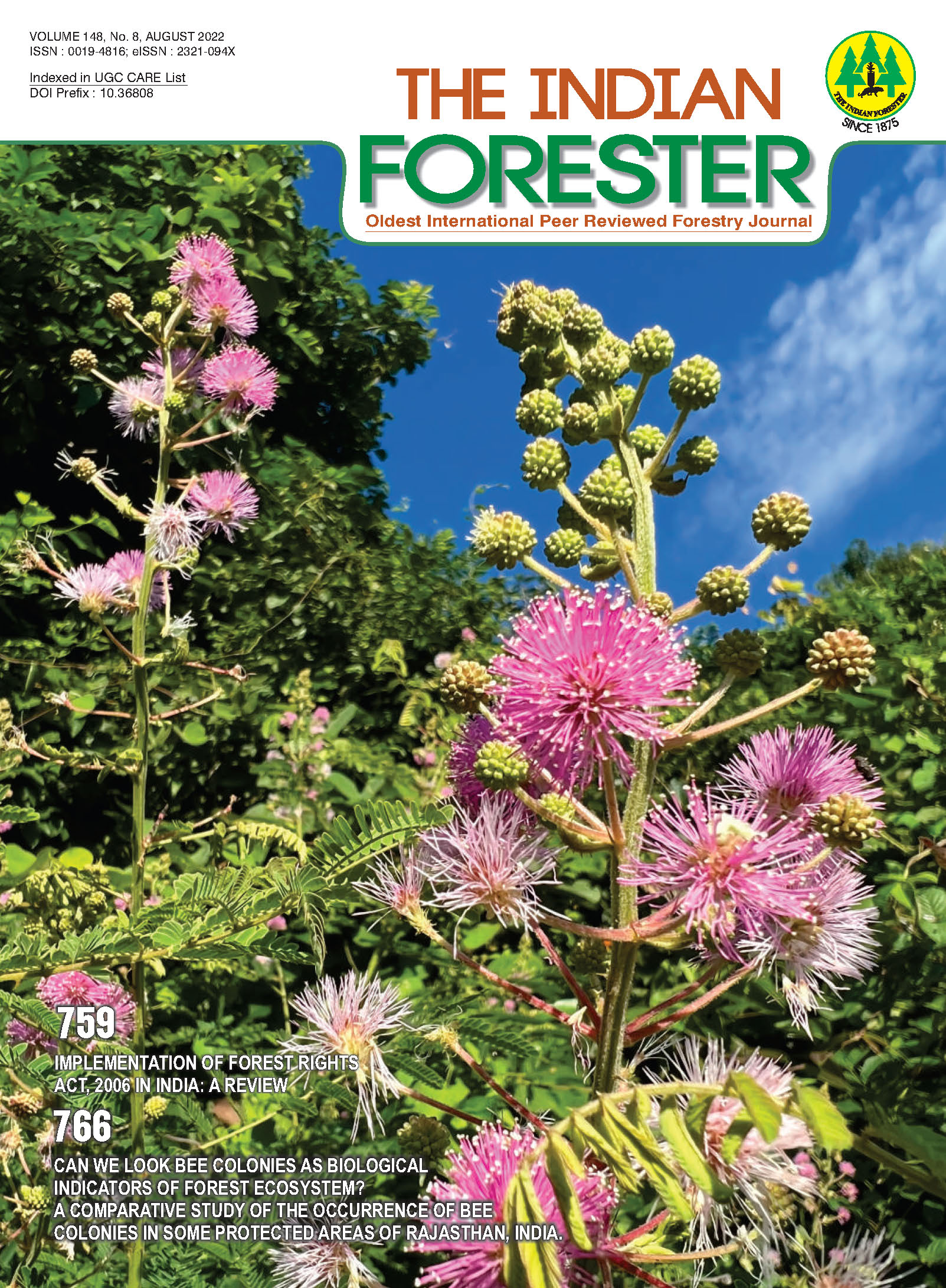Ethnomedicinal Studies on Wild Medicinal Plants of Yusmarg Valley of District Budgam (Western Himalaya), in Jammu and Kashmir
DOI:
https://doi.org/10.36808/if/2022/v148i8/157058Keywords:
Medicinal plants, Traditional knowledge, Tribal people, Yusmarg, Budgam.Abstract
Yusmarg valley is well known for its temperate vegetation of western Himalaya and located in Budgam district of Jammu and Kashmir. Medicinal plants are being used frequently by local tribal communities of the area for the treatment of various ailments. This is the first study which has examined the medicinal plant use in Yusmarg valley by local communities. During the study a total of 50medicinal plants belonging to 47 genera and 22 families were recorded to be used for obtaining primary health care by the local tribal communities. Asteraceae was found to be the dominant family with a species contribution of nine species. Most of the species were harvested for leaves (16-species). Herbs (45-species) were the major life form used for medicinal purpose. The issues related to current status of knowledge on medicinal plants used by indigenous communities of J&K have been discussed and it is recommended that this indigenous knowledge which is confined to old age folks only, should be conserved so as to make it available for future generations. In addition, medicinal flora of the area is under great threat due to tourist activities so the conservation is needed on priority basis.References
Anzar A.A., Rashid I., Reshi Z., Dar G.H. and Wafai B.A. (2007). The Alien Flora of Kashmir Himalaya. Biological Invasions, 9: 262-292.
Ballabh B. and Chaurasia O.P. (2009). Medicinal plants of cold desert Ladakh used in the treatment of stomach disorders. Indian Journal of Traditional Knowledge, 8: 185-190.
Cox P.A. and Balick M.J. (1994). The ethnobotanical approach to drug discovery. Scientific American, 270(6): 82-87.
Hooker J.D. (1879). The Flora of British India, Vol 2. L. Reeve and Co., Ashford, Kent, England. 78-99 p.
Jan M., Mir T.A. and Khare R.K. (2020).Indigenous medicinal usage of family Solanaceae and Polygonaceae in Uri, Baramulla, Jammu and Kashmir.Journal of Medicinal Herbs and Ethnomedicine, 6: 86-89.
Joshi M., Kumar M. and Bussmann R.W. (2010). Ethnomedicinal Uses of Plant Resources of the Haigad Watershed in Kumaun Himalaya, Journal of Medicinal and Aromatic Plant Science and Biotechnology, 4(1): 43-46.
Kaul M.K., Sharma P.K. and Singh V. (1995). Crude Drugs of Zanskar (Ladakh) used in Amchi System of Traditional Medicine. Glimpses of Indian Ethno Pharmacology, India, 163-172 p.
Khan A.M., Khan, Z.N. and Wahab M. (2010). Ethnobotanical studies on useful shrubs of district Kotli, Azad Jammu & Kashmir, Pakistan. Pakistan Journal of Botany, 42(3): 1407-1415.
Kumar A.K. and Katakam A. (2002).Credit for conservation. Frontline, 19: 9-22.
Lewis W.H. (2003). Pharmacceutical discoveries based on ethnobotanical plants: 1985 to 2000 and beyond. Economic Botany, 57(1): 126-134.
Malik A.H., Khuroo A.A., Dar G.H. and Khan Z.S. (2011). Ethnomedicinal uses of some plants in the Kashmir Himalaya. Indian Journal of Traditional Knowledge, 10(2): 362-366.
Martin J.G. (2008). Ethnobotany (Methods Mannual). Chapman and Hall, London.
Miller J.S. (2011). The discovery of medicines from plants: a current biological perspective. Economic Botany, 65(4): 396-407.
Navchoo I.A. and Kachroo P. (1995). Flora of Pulwama, Kashmir.Bishen Singh and Mahendra Pal Singh, Dehradun.
Newman D.J. and Cragg G.M. (2007). Natural products as sources of new drugs over the late 25 years.Journal of Natural Product, 70: 46-477.
Rossato S.C., De LeitãO-Filho H.F. and Begossi A. (1999). Ethnobotany of caiçaras of the Atlantic Forest coast (Brazil).Economic Botany, 53(4): 387-395.
Samant S.S., Dhar U. and Palni L.M.S. (1998). Medicinal Plants of Indian Himalaya: Diversity Distribution Potential Values. GyanodayaPrakashan, Nanital.
Shah A., Bharati K.A., Ahmad J. and Sharma M.P. (2015). New ethnomedicinal claims from Gujjar and Bakerwals tribes of Rajouri-Poonch districts of Jammu and Kashmir, India. Journal of Ethnopharmacology, 166: 119-128.
Shawl A.S., Kumar T. Chishti N. and Shabir S. (2006). Cultivation of rose scented geranium (Pelargonium sp.) as a cash crop in Kashmir Valley. Asian Journal of Plant Science, 5: 673-675.
Singh A.G., Panthi M.P. and Tewari D.D. (2011). Ethnomedicinal Plants used by Tharu and Magar Communities of Rupandehi District, Western Nepal. Current Botany, 2: 30-33.
Singh J.B. and Kachroo P. (1994). Forest Flora of PirPanjal Range: North Western Himalaya. Bishen Singh Mahendra Pal Singh, Dehradun, India.
Singh J.S. (2006). Sustainable development of the Indian Himalayan region: Linking ecological and economic concerns. Current Science, 90: 784-788.
Singh N.P., Singh D.K. and Uniyal B.P. (2002). Flora of Jammu & Kashmir: Pteridophytes Gymnosperms and Angiosperms, Vol. 1. Botanical Survey of India, New Delhi, India.
Singh V. (1995). Herbal remedies in traditional medicines of the local valley in Kashmir Himalayas, India, round progress in medicinal plants. Ethno-Medicinal Pharmacology, 1: 63-71.
Upton R., Graff A., Jolliffe G., Langer R. and Williamson E. (2011). American Herbal Pharmacopoeia: Botanical Pharmacognosy-Microscopic Characterization of Botanical Medicines.CRC Press, USA.
Wagay N.A. (2016). Ethnobotany from North Kashmir: A review. Life Science Leaflets, 80: 38-60.
Downloads
Downloads
Published
How to Cite
Issue
Section
License
Unless otherwise stated, copyright or similar rights in all materials presented on the site, including graphical images, are owned by Indian Forester.





